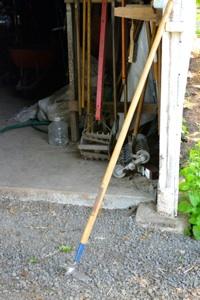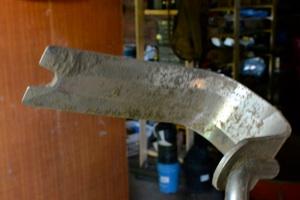|
|
|||
 |
|||
Heron Hoe REVIEW June 2011 I’ve been meaning to write a review of the Heron for almost a year now. Ironically, this is the first review for the site that I’m writing and its for a product that was sent to me for free, by the manufacturer. They offered right after I wrote an article on hoes and how to use them in Growing For Market (May 2010), and I said yes, I was curious. I didn’t promise anything other than an honest review after I’d had time to test it out, and so that’s finally what I’m getting around to. I expect pretty much every other review on this site will end up being for something that I’ve actually bought. |
|
 |
||
I’m a little embarrassed to say that it has actually become the hoe I pick up more often than any other. I’m especially embarrassed because my initial impression from the ads I saw and their marketing was that it couldn’t possibly be as good as they were saying, but actually their marketing isn’t too far from my experience. The thing I was most skeptical about was the idea that the hoe wouldn’t need sharpening, and in fact, I’ve been using it for almost a year now, I’ve never sharpened it, and it’s still quite sharp, at least very usably sharp, and way better than most hoes right off the shelf. The hoe, in my ideal of a hoe, is not the prettiest and it shares two cosmetic features with cheap flimsy hoes that distracted me at first from the quality of its build and its functionality. First, on first inspection the connection of the blade to the handle is a tang type, with the end of the handle being covered with a metal sleeve (called a ferrule) to keep the wood from splitting. Normally this would be an obvious point of failure as the tool ages, the wood dries and the tang and ferrule work themselves loose. The difference here, on closer inspection, is that they seem to have made a much larger tang, which is not from stamped metal, but heavy gage stainless, and they’ve sealed the whole thing with what appears to be 2 part expoxy - very tough, stiff and strong connection and it hasn’t loosened at all even with some decent chopping. The second thing I noticed was that the handle was coated in varnish, like most handles. This protects the wood, but it’s not as comfortable to work with as an oiled handle and eventually it does wear off. They’ve put a very heavy coat on so it probably won’t wear off as quickly as a cheap tool, but I’m still tempted to sand it off, as I’ve done with other tools, and replace it with linseed which makes a very comfortable soft grip, in my opinion. The really special thing about this hoe is the design of the blade. It looks a little odd, but working with it there are some great features. The blade does a nice job of sitting flat on the ground, like it should. The long, relatively flat bevel with the hard stainless metal keeps the edges sharp enough to slice through weeds and the soil with relative ease. Part of this is also the high polish on the steel, which doesn’t stick to soil the way carbon steel does. It’s not that soil doesn’t stick at all, just not as much, and that makes a difference. |
|
 |
||
The blade has one side that will slide under crops, or drip tape, which is a great feature. The tip on that side is notched which allows a slight grabbing motion for larger weeds that are right next to something else you don’t want to cut and it is a feature that I use. The other side of the blade comes up out of the ground so you can see your edge and that’s useful for getting up close to plants or edges when things are delicate and you want to make sure not to catch them, or bury them with the tip. Fortunately they’ve run the bevel up this edge as well, which makes a big difference. (I apologize for the poor quality photos, I’ve been so busy using the hoe myself I haven’t given it up to let anyone else use it so I can take a proper picture of the thing in use, I’ll try to get one soon) The hoe can be used in several other positions and it actually comes with a users guide, which is a great feature. I do use it for making furrows for planting beans and other large seeds sometimes. It’s pretty good at this, not great. It does work well, upside down, for filling the furrow back in, and you can kind of use it to firm things in place but it’s a little awkward for my tastes (not that other hoes do this any better, or at all). That’s fine though, they market as a do everything tool, and it can, but what it’s really great for is cutting off weeds and loosening the surface of the soil. In some sense it’s a bit like a shallow rototiller when you want it to be. If you think about it, and look at the tines on the tiller, they’re very similar to this hoe. The handle on this model is a little heavier than I like, but that allows it to be very stiff and to be used for light chopping, which I appreciate. It also transfers force well to the ground, and I don’t notice the weight so much when it’s actually in the ground. It is a little shorter than I’d like. I’m 6’1 and the handle is only 5’ long, a pretty standard handle length. I haven’t tried it yet, but I think it would be great with a mushroom grip from Johnny’s. I find myself pushing on the end of the handle, to avoid stooping. If I only had one hoe, this would be a great option, I actually can’t think of a better option. I do have several other hoes though, and I still use the others, just not nearly as much as I used to. |
|
© joshvolk.com |
|

